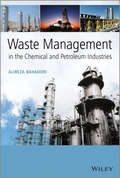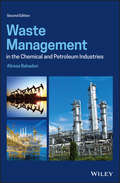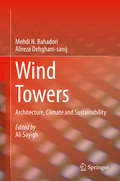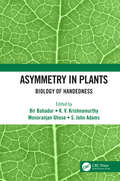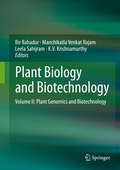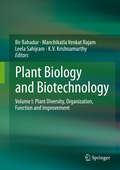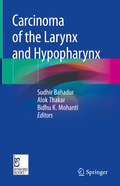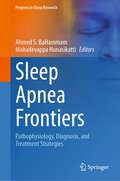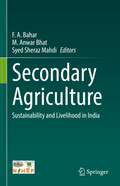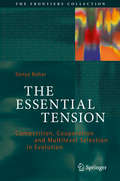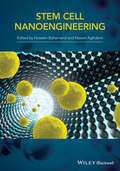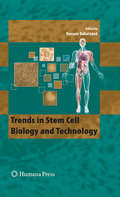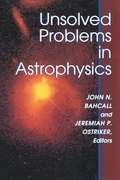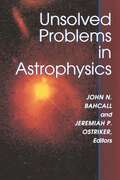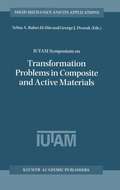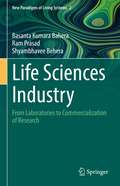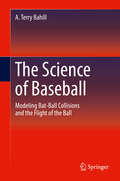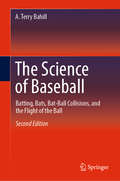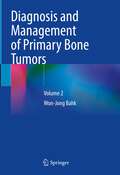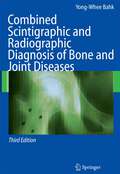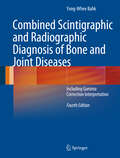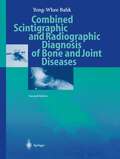- Table View
- List View
Waste Management in the Chemical and Petroleum Industries
by Alireza BahadoriThe global chemical and petroleum industries have always had the challenge of disposing of chemical wastes, by-products, and residuals, but with traditional techniques such as deep well injection and incineration proving flawed, the need for disposal by legal, safe and economically effective means has never been greater. Increasingly, the need to produce without pollution is the preferred model for industry, and the strategy of waste minimization is seen as the best way forward. This is particularly relevant in the petrochemical and chemical industries, where large quantities of hazardous and toxic wastes are produced which can pose formidable disposal problems. Covering the essentials of treatment, recovery and disposal of waste, as well as the requirements for process design and engineering of equipment and facilities in the chemical and petroleum industries, this book includes chapters on: Wastewater Treatment Physical Unit Operations Chemical Treatment Biological Treatment Wastewater Treatment in Unconventional Oil and Gas Industries Wastewater Sewer Systems Sewage Treatment Solid Waste Treatment and Disposal Primarily aimed at researchers and advanced students in chemical, petroleum, and environmental fields as well as those in civil engineering, this book should also provide a unique reference for industry practitioners and anyone interested in chemical and petroleum waste treatment and disposal.
Waste Management in the Chemical and Petroleum Industries
by Alireza BahadoriUnravels fundamental engineering for the treatment, recovery, and disposal of solid waste, sludge and wastewater in the petroleum, chemical, and unconventional oil and gas processing industries This new edition unravels essential requirements for the process design and engineering of the equipment and facilities pertaining to waste management for gas refineries, chemical plants, oil terminals, and petrochemical plants. Updated throughout, Waste Management in the Chemical and Petroleum Industries, Second Edition offers chapters on wastewater treatment; physical unit operations; chemical treatment; biological treatment; and wastewater treatment in unconventional oil and gas industries. It also covers wastewater sewer systems; sewage treatment; and solid waste treatment and disposal. New topics include: water pollution terminals the design procedure for effluent water pollution control spill prevention and control groundwater pollution control wastewater pollution control in crude oil terminals Information on the source of polymeric plants examination of water and wastewater radioactivity soil pollution pipeline leak consequence evaluation Waste Management in the Chemical and Petroleum Industries, Second Edition is an ideal text for researchers and advanced students in chemical, petroleum, and environmental fields, as well as for those in civil engineering.
Waste Management in the Chemical and Petroleum Industries
by Alireza BahadoriUnravels fundamental engineering for the treatment, recovery, and disposal of solid waste, sludge and wastewater in the petroleum, chemical, and unconventional oil and gas processing industries This new edition unravels essential requirements for the process design and engineering of the equipment and facilities pertaining to waste management for gas refineries, chemical plants, oil terminals, and petrochemical plants. Updated throughout, Waste Management in the Chemical and Petroleum Industries, Second Edition offers chapters on wastewater treatment; physical unit operations; chemical treatment; biological treatment; and wastewater treatment in unconventional oil and gas industries. It also covers wastewater sewer systems; sewage treatment; and solid waste treatment and disposal. New topics include: water pollution terminals the design procedure for effluent water pollution control spill prevention and control groundwater pollution control wastewater pollution control in crude oil terminals Information on the source of polymeric plants examination of water and wastewater radioactivity soil pollution pipeline leak consequence evaluation Waste Management in the Chemical and Petroleum Industries, Second Edition is an ideal text for researchers and advanced students in chemical, petroleum, and environmental fields, as well as for those in civil engineering.
Wind Towers: Architecture, Climate and Sustainability
by Mehdi N. Bahadori Alireza Dehghani-sanij Ali SayighThis unique volume provides the only holistic treatment of wind towers, a core aspect of sustainable architecture in hot, arid climates. The authors explain how traditional incarnations of these structures provide significant decreases in energy consumption through their use of renewable wind resources to cool buildings and water storage facilities. Beginning with the underlying scientific principles, the design and operation of wind towers is explained in depth and suggestions for optimization are provided, supported by the authors' findings from recent analytical studies.
Asymmetry in Plants: Biology of Handedness
by Bir Bahadur K. V. Krishnamurthy Manoranjan Ghose S. John AdamsPlants exhibit forms of asymmetry analogous to "handedness" in bilaterally symmetrical animals. This book explores the evolutionary significance and development of asymmetry. Examples of genetic control include the direction of tendril or stem coiling of many climbing plants; the so-called spiral phyllotaxy and floral taxy; and contorted petal arrangement is another kind of left- right symmetry in plants; the direction of contortion is fixed in some but not in other plants. The book will underscore tha all phenomena related to handedness start during embryogenesis itself, with the occurrence of embryo rotation. Key selling features: First consolidated book on Plant Handedness Relates handedness, asymmetry and chirality to the evolution of different organizational levels in plant biology Emphasizes handedness as a vital governing force in plant functional evolution Provides a new perspective, hitherto ignored, into plant developemtn and evolution Describes how an age-old phenomenon can give scope for investigation from a very modern interdisciplinary approach
Asymmetry in Plants: Biology of Handedness
by Bir Bahadur K. V. Krishnamurthy Monoranjan Ghose S. John AdamsPlants exhibit forms of asymmetry analogous to "handedness" in bilaterally symmetrical animals. This book explores the evolutionary significance and development of asymmetry. Examples of genetic control include the direction of tendril or stem coiling of many climbing plants; the so-called spiral phyllotaxy and floral taxy; and contorted petal arrangement is another kind of left- right symmetry in plants; the direction of contortion is fixed in some but not in other plants. The book will underscore tha all phenomena related to handedness start during embryogenesis itself, with the occurrence of embryo rotation. Key selling features: First consolidated book on Plant Handedness Relates handedness, asymmetry and chirality to the evolution of different organizational levels in plant biology Emphasizes handedness as a vital governing force in plant functional evolution Provides a new perspective, hitherto ignored, into plant developemtn and evolution Describes how an age-old phenomenon can give scope for investigation from a very modern interdisciplinary approach
Plant Biology and Biotechnology: Volume II: Plant Genomics and Biotechnology
by Bir Bahadur Manchikatla Venkat Rajam Leela Sahijram K. V. KrishnamurthyPlant genomics and biotechnology have recently made enormous strides, and hold the potential to benefit agriculture, the environment and various other dimensions of the human endeavor. It is no exaggeration to claim that the twenty-first century belongs to biotechnology. Knowledge generation in this field is growing at a frenetic pace, and keeping abreast of the latest advances and calls on us to double our efforts. Volume II of this two-part series addresses cutting-edge aspects of plant genomics and biotechnology. It includes 37 chapters contributed by over 70 researchers, each of which is an expert in his/her own field of research.Biotechnology has helped to solve many conundrums of plant life that had long remained a mystery to mankind. This volume opens with an exhaustive chapter on the role played by thale cress, Arabidopsis thaliana, which is believed to be the Drosophila of the plant kingdom and an invaluable model plant for understanding basic concepts in plant biology. This is followed by chapters on bioremediation, biofuels and biofertilizers through microalgal manipulation, making it a commercializable prospect; discerning finer details of biotic stress with plant-fungal interactions; and the dynamics of abiotic and biotic stresses, which also figure elsewhere in the book.Breeding crop plants for desirable traits has long been an endeavor of biotechnologists. The significance of molecular markers, marker assisted selection and techniques are covered in a dedicated chapter, as are comprehensive reviews on plant molecular biology, DNA fingerprinting techniques, genomic structure and functional genomics. A chapter dedicated to organellar genomes provides extensive information on this important aspect. Elsewhere in the book, the newly emerging area of epigenetics is presented as seen through the lens of biotechnology, showcasing the pivotal role of DNA methylation in effecting permanent and transient changes to the genome. Exclusive chapters deal with bioinformatics and systems biology. Handy tools for practical applications such as somatic embryogenesis and micropropagation are included to provide frontline information to entrepreneurs, as is a chapter on somaclonal variation.Overcoming barriers to sexual incompatibility has also long been a focus of biotechnology, and is addressed in chapters on wide hybridization and hybrid embryo rescue. Another area of accomplishing triploids through endosperm culture is included as a non-conventional breeding strategy. Secondary metabolite production through tissue cultures, which is of importance to industrial scientists, is also covered.Worldwide exchange of plant genetic material is currently an essential topic, as is conserving natural resources in situ. Chapters on in vitro conservation of extant, threatened and other valuable germplasms, gene banking and related issues are included, along with an extensive account of the biotechnology of spices – the low-volume, high-value crops. Metabolic engineering is another emerging field that provides commercial opportunities. As is well known, there is widespread concern over genetically modified crops among the public. GM crops are covered, as are genetic engineering strategies for combating biotic and abiotic stresses where no other solutions are in sight. RNAi- and micro RNA- based strategies for crop improvement have proved to offer novel alternatives to the existing non-conventional techniques, and detailed information on these aspects is also included. The book’s last five chapters are devoted to presenting the various aspects of environmental, marine, desert and rural biotechnology. The state-of-the-art coverage on a wide range of plant genomics and biotechnology topics will be of great interest to post-graduate students and researchers, including the employees of seed and biotechnology companies, and to instructors in the fields of plant genetics, breeding and biotechnology.
Plant Biology and Biotechnology: Volume I: Plant Diversity, Organization, Function and Improvement
by Bir Bahadur Manchikatla Venkat Rajam Leela Sahijram K. V. KrishnamurthyThis volume offers a much-needed compilation of essential reviews on diverse aspects of plant biology, written by eminent botanists. These reviews effectively cover a wide range of aspects of plant biology that have contemporary relevance. At the same time they integrate classical morphology with molecular biology, physiology with pattern formation, growth with genomics, development with morphogenesis, and classical crop-improvement techniques with modern breeding methodologies. Classical botany has been transformed into cutting-edge plant biology, thus providing the theoretical basis for plant biotechnology.It goes without saying that biotechnology has emerged as a powerful discipline of Biology in the last three decades. Biotechnological tools, techniques and information, used in combination with appropriate planning and execution, have already contributed significantly to economic growth and development. It is estimated that in the next decade or two, products and processes made possible by biotechnology will account for over 60% of worldwide commerce and output. There is, therefore, a need to arrive at a general understanding and common approach to issues related to the nature, possession, conservation and use of biodiversity, as it provides the raw material for biotechnology. More than 90% of the total requirements for the biotechnology industry are contributed by plants and microbes, in terms of goods and services. There are however substantial plant and microbial resources that are waiting for biotechnological exploitation in the near future through effective bioprospection. In order to exploit plants and microbes for their useful products and processes, we need to first understand their basic structure, organization, growth and development, cellular process and overall biology. We also need to identify and develop strategies to improve the productivity of plants.In view of the above, in this two-volume book on plant biology and biotechnology, the first volume is devoted to various aspects of plant biology and crop improvement. It includes 33 chapters contributed by 50 researchers, each of which is an expert in his/her own field of research. The book begins with an introductory chapter that gives a lucid account on the past, present and future of plant biology, thereby providing a perfect historical foundation for the chapters that follow. Four chapters are devoted to details on the structural and developmental aspects of the structures of plants and their principal organs. These chapters provide the molecular biological basis for the regulation of morphogenesis of the form of plants and their organs, involving control at the cellular and tissue levels. Details on biodiversity, the basic raw material for biotechnology, are discussed in a separate chapter, in which emphasis is placed on the genetic, species and ecosystem diversities and their conservation.Since fungi and other microbes form an important component of the overall biodiversity, special attention is paid to the treatment of fungi and other microbes in this volume. Four chapters respectively deal with an overview of fungi, arbuscularmycorrhizae and their relation to the sustenance of plant wealth, diversity and practical applications of mushrooms, and lichens (associated with a photobiont). Microbial endosymbionts associated with plants and phosphate solubilizing microbes in the rhizosphere of plants are exhaustively treated in two separate chapters. The reproductive strategies of bryophytes and an overview on Cycads form the subject matter of another two chapters, thus fulfilling the need to deal with the non-flowering Embryophyte group of plants.Angiosperms, the most important group of plants from a biotechnological perspective, are examined exhaustively in this volume. The chapters on angiosperms provide an overview and cover the genetic basis of flowers development, pre-and post-fertilization reproductive growth and development, seed biology and technology, plant secondary metabolism, photosynthesis, and plant volatile chemicals. A special effort ha
Carcinoma of the Larynx and Hypopharynx
by Sudhir Bahadur Alok Thakar Bidhu K. MohantiCarcinomas of the larynx and hypopharynx present unique challenges when it comes to their assessment and management. Management involves the essential dilemma of optimizing cure rates while also ensuring that potential disability due to compromised airway, voice and swallowing is minimized. Treatment decisions involve careful disease assessment, judicious multispecialty decision-making, and subsequent meticulous implementation of the selected treatment modalities.The critical nature of each of these steps has led to dramatic advances in assessment techniques (radiology, endoscopy and photography, stroboscopy, narrow band imaging, contact endoscopy) and also in treatment methods (radiation therapy, combined concurrent chemo-radiation, combined sequential chemo-radiation, trans-oral CO2 laser and robotic surgery, partial laryngectomy, total laryngectomy, extended total laryngectomy). As such, treatment decisions have become increasingly complex with the twin objectives of maximizing cure as well as function preservation and are based on tumor stage, tumor location, systemic co-morbidities, nutritional status, patient priorities, and social and economic factors. This multidisciplinary book has been written by a team of editors with considerable experience and expertise in these critical areas and a deep understanding of teamwork and the strengths and limitations of individual technologies and treatments. It presents a homogeneous and unbiased view that is applicable to all specialties involved in the care of larynx and hypopharynx cancers.
Sleep Apnea Frontiers: Pathophysiology, Diagnosis, and Treatment Strategies (Progress in Sleep Research)
by Ahmed S. BaHammam Mahadevappa HunasikattiThis book delves into the multifaceted world of sleep apnea, presenting the latest advancements, challenges, and perspectives in the field. The book covers various topics, including neuro-stimulator use, positive airway pressure therapies, non-PAP and non-surgical treatments, surgical interventions, diagnosis and management of various sleep apnea phenotypes and comorbidities, and special populations such as pediatric and intensive care unit patients. The book discusses the pathophysiology and mechanisms underlying sleep apnea, examining the role of circulating miRNA as a potential biomarker for diagnosis. It also addresses the adverse health consequences associated with sleep apnea, including cardiovascular disease, diabetes, cancer, and hypertension. Furthermore, the book explores the application of telemedicine and wearable technologies in diagnosing and treating sleep apnea, as well as the impact of external factors such as the COVID-19 pandemic and traffic safety concerns related to sleep deprivation and sleep disorders. The book also highlights the importance of perioperative assessment and management of patients with sleep disorders, the role of REM sleep in sleep disorders, recent advances in sleep during pregnancy and postpartum, and the influence of sleep disturbances on hospitalized and intensive care unit patients. With contributions from experts in the field, this book offers valuable insights into the current state of sleep apnea research and practice, serving as a solid foundation for healthcare professionals, researchers, and students interested in understanding and addressing this prevalent sleep disorder. By providing a comprehensive overview of the field, this book aims to inspire further research and innovation in the diagnosis, treatment, and management of sleep apnea and related sleep disorders.
Secondary Agriculture: Sustainability and Livelihood in India
by F. A. Bahar M. Anwar Bhat Syed Sheraz MahdiThis book on ‘Secondary Agriculture’ discusses the goal of doubling farmers’ incomes. The term ‘secondary’ has a bearing on climate change adaptation and its mitigation, small farm viability and profitability, food security, nutrition, sustainable utilization of natural resources, and optimal usage of produce from primary agriculture and farm incomes. Promoting secondary agriculture has implications on attaining sustainable development goals, which aim to connect primary, secondary and tertiary sectors by using slack/idle factors of production, such as land and labour, contributing to primary agriculture production, capturing ‘value’ in primary agricultural activities, and generating additional income at the enterprise level. In context to same, the chapters of this book have been designed to promote secondary agriculture through low-cost skills and technology applications in agriculture and by upscaling knowledge via integrating primary, secondary and tertiary sectors of agriculture. The motivation behind this book is to address the challenges of biotic and abiotic stresses facing the farming community; to increase farmers income through low-cost skills and technology applications in agriculture; to upscale knowledge by integrating primary, secondary and tertiary sectors of agriculture. The food processing sector in India is still in a nascent stage with only 8 per cent of the produce being processed as against 80-98 per cent in case of high-income countries (Government of India, 2008, 2010). The food processing sector is now receiving the boost with the annual growth of 13.2 per cent in registered food processing units during 2004-10 (Government of India, 2011). Against this backdrop, there is a strong need to strategically handle the situation in order to facilitate a self-sustainable and long-run growth of the sector, which is felt possible by focusing on Secondary Agriculture. Though not a panacea for all ailments of the primary sector, but it can definitely drive the growth.
The Essential Tension: Competition, Cooperation and Multilevel Selection in Evolution (The Frontiers Collection)
by Sonya Bahar'The Essential Tension' explores how agents that naturally compete come to act together as a group. The author argues that the controversial concept of multilevel selection is essential to biological evolution, a proposition set to stimulate new debate. The idea of one collective unit emerging from the cooperative interactions of its constituent (and mutually competitive) parts has its roots in the ancient world. More recently, it has illuminated studies of animal behavior, and played a controversial role in evolutionary biology. In Part I, the author explores the historical development of the idea of a collectivity in biological systems, from early speculations on the sociology of human crowd behavior, through the mid-twentieth century debates over the role of group selection in evolution, to the notion of the selfish gene. Part II investigates the balance between competition and cooperation in a range of contemporary biological problems, from flocking and swarming to experimental evolution and the evolution of multicellularity. Part III addresses experimental studies of cooperation and competition, as well as controversial ideas such as the evolution of evolvability and Stephen Jay Gould’s suggestion that “spandrels” at one level of selection serve as possible sources of variability for the next higher level. Finally, building on the foundation established in the preceding chapters, the author arrives at a provocative new proposition: as a result of the essential tension between competition and cooperation, multiple levels may be essential in order for evolutionary processes to occur at all.
Stem-Cell Nanoengineering
by H. BaharvandStem Cell Nanoengineering reviews the applications of nanotechnology in the fields of stem cells, tissue engineering, and regenerative medicine. Topics addressed include various types of stem cells, underlying principles of nanobiotechnology, the making of nano-scaffolds, nano tissue engineering, applications of nanotechnology in stem cell tracking and molecular imaging, nano-devices, as well as stem cell nano-engineering from bench to bedside. Written by renowned experts in their respective fields, chapters describe and explore a wide variety of topics in stem cell nanoengineering, making the book a valuable resource for both researchers and clinicians in biomedical and bioengineering fields.
Stem-Cell Nanoengineering
by H. BaharvandStem Cell Nanoengineering reviews the applications of nanotechnology in the fields of stem cells, tissue engineering, and regenerative medicine. Topics addressed include various types of stem cells, underlying principles of nanobiotechnology, the making of nano-scaffolds, nano tissue engineering, applications of nanotechnology in stem cell tracking and molecular imaging, nano-devices, as well as stem cell nano-engineering from bench to bedside. Written by renowned experts in their respective fields, chapters describe and explore a wide variety of topics in stem cell nanoengineering, making the book a valuable resource for both researchers and clinicians in biomedical and bioengineering fields.
Trends in Stem Cell Biology and Technology
by Hossein BaharvandStem cells, characterized by the ability to both self-renew and to generate diff- entiated functional cell types, have been derived from the embryo and from va- ous sources of the postnatal animals and human. The recent advances in stem cell research have led to a better understanding of self-renewal, maintenance, and diff- entiation of both embryonic and somatic stem cells. This has significantly increased our knowledge of cellular and developmental biology in general and will certainly continue to do so for a long time to come. Moreover, given their role in maintaining and replenishing tissues, stem cells represent a potential means of restoring tissue function and thereby treating the root cause of degenerative disease. Therefore, in parallel, we need to improve our cognizance of the challenges involved in applying stem cells in clinical settings. The current chapters highlight both of these aspects: that of understanding the “actual” and that of developing the “possible. ” In recognition of the growing excitement and potential of stem cells as models for both the advancement of basic science and future clinical applications, I felt it timely to edit this book in which forefront investigators would provide new findings for the use of stem cells to study various lineages and tissue types and some app- cations.
Unsolved Problems in Astrophysics
by John N. Bahcall Jeremiah P. OstrikerThe field of astrophysics is in the midst of a technologically driven renaissance, as fundamental discoveries are being made with astonishing frequency. In the last decade, new detectors in space, on earth, and deep underground have, when coupled with the computational power of modern computers, revolutionized our knowledge and understanding of the astronomical world. This is a great time for a student of any age to become acquainted with the remarkable universe in which we live. This volume is a collection of essays, originally presented orally to a diverse group of students and professionals, which reveal the most fertile areas for future study of astronomy and astrophysics. The emphasis of this work is on the clear description of the current state of our knowledge as a preparation for the future unraveling of the mysteries of the universe that appear today as most fundamental and most amenable to solution. A stellar group of astronomers and astrophysicists describes the directions and styles of work that they think are most likely to lead to progress. Bibliographical notes at the end of each presentation provide guidance for the reader who wishes to go more deeply into a given subject. Unsolved Problems in Astrophysics is a uniquely stimulating introduction to some of the most important topics in modern astrophysics.
Unsolved Problems in Astrophysics (Princeton Series in Astrophysics (PDF) #8)
by John N. Bahcall Jeremiah P. OstrikerThe field of astrophysics is in the midst of a technologically driven renaissance, as fundamental discoveries are being made with astonishing frequency. In the last decade, new detectors in space, on earth, and deep underground have, when coupled with the computational power of modern computers, revolutionized our knowledge and understanding of the astronomical world. This is a great time for a student of any age to become acquainted with the remarkable universe in which we live. This volume is a collection of essays, originally presented orally to a diverse group of students and professionals, which reveal the most fertile areas for future study of astronomy and astrophysics. The emphasis of this work is on the clear description of the current state of our knowledge as a preparation for the future unraveling of the mysteries of the universe that appear today as most fundamental and most amenable to solution. A stellar group of astronomers and astrophysicists describes the directions and styles of work that they think are most likely to lead to progress. Bibliographical notes at the end of each presentation provide guidance for the reader who wishes to go more deeply into a given subject. Unsolved Problems in Astrophysics is a uniquely stimulating introduction to some of the most important topics in modern astrophysics.
IUTAM Symposium on Transformation Problems in Composite and Active Materials: Proceedings of the IUTAM Symposium held in Cairo, Egypt, 9–12 March 1997 (Solid Mechanics and Its Applications #60)
by Yehia A. Bahei-El-Din George J. DvorakThe field of composite materials has seen substantial development in the past decade, New composite systems are being continually developed for various applications. Among such systems are metal, intermetallic, and superalloy matrix composites, carbon-carbon composites as well as polymer matrix composites. At the same time, a new discipline has emerged of active or smart materials, which are often constructed as composite or heterogeneous media and structures. One unifying theme in these diverse systems is the influence that uncoupled and coupled eigenfields or transformation fields exert on the various types of overall response, as well as on the respective phase responses. Problems of this kind are currently considered by different groups which may not always appreciate the similarities of the problems involved. The purpose of the IUTAM Symposium on Transformation Problems in Composite and Active Materials held in Cairo, Egypt from March 10 to 12, 1997 was to bring together representatives of the different groups so that they may interact and explore common aspects of these seemingly different problem areas. New directions in micromechanics research in both composite and active materials were also explored in the symposium. Specifically, invited lectures in the areas of inelastic behavior of composite materials, shape memory effects, functionally graded materials, transformation problems in composite structures, and adaptive structures were delivered and discussed during the three-day meeting. This book contains the printed contributions to the IUTAM Symposium.
Life Sciences Industry: From Laboratories to Commercialization of Research (New Paradigms of Living Systems #2)
by Basanta Kumara Bahera Ram Prasad Shyambhavee BeheraBasic principles of applied life sciences such as recombinant DNA technology is used in most life sciences industries marketing bio-formulations for designing more effective protein-based drugs, such as erythropoietin and fast-acting insulin etc. In recent times genetically engineered host cells from mammal, animal and plants are also being used in life sciences industries to manufacture biologics. This book discusses the most basic as well advanced issues on biological products for successfully managing a life sciences industry. It elucidates the life cycle of biological molecules, right from the conceptual development of different types of biopolymers, and their subsequent transfer from the conical flasks in laboratory to life sciences industries for large scale production and marketing. It focuses on sustainable longevity in the life cycle of commercial biopolymers. Cumulative facts and figures in this volume would immensely help in inspiring life sciences industry promoters to monitor value chain transfer process of biologics for better profitability. Additionally, it would serve as a perusal document for the students and researchers interested in entrepreneurial ventures or having their own start-up projects for the commercialization of biologics.
The Science of Baseball: Modeling Bat-Ball Collisions and the Flight of the Ball
by A. Terry BahillThis book describes the dynamic collisions between baseballs, softballs, and bats, and the intricate modeling of these interactions, using only Newton’s basic principles and the conservation laws of physics. Veteran baseball science author Terry Bahill explains models for the speed and spin of balls and bats and equations for bat-ball collisions at a level accessible to high school and undergraduate physics students, engineering students, and, most importantly, students of the science of baseball. Unlike other, more technical accounts of these phenomena that exhibit similar rigor, the models presented in this volume use only basic physical principles to describe simple collision configurations. Elucidating the most important factors for understanding bat performance—bat weight, moment of inertia, the coefficient of restitution, and characteristics of humans swinging the bats, Dr. Bahill also explains physical aspects of the ideal bat and the sweet spot.• Explains how to select or design an optimal baseball or softball bat and create models for bat-ball collisions using only fundamental principles of mechanics from high school physics;• Describes the results of the collision between baseball and bat using basic mathematics such as equations for the speed of the ball after the collision, bat speed after the collision, and bat rotation after the collision;•Accessible to high school and undergraduate students as well as non-technical aficionados of the science of baseball. “Dr. Bahill’s book is the perfect tool for teaching how to solve some of baseball’s basic science problems. Using only simple Newtonian principles and the conservation laws, Dr. Bahill explains how to model bat-ball collisions. Also, he derives equations governing the flight of the ball, and proceeds to show what factors affect air density and how this density affects the ball’s flight. And as a unique addition to his fine book, he provides advice for selecting the optimal bat—a surprising bonus!”Dave Baldwin, PhDMajor League pitcher, 1966-1973, lifetime Major League ERA, 3.08 “If I were the General Manger of a baseball team, I would tell my people to write a ten-page paper describing what this book contains that could improve our performance. I think the book provides the foundation for change.”Bruce GissingExecutive VP-Operations (retired) Boeing Commercial Airplanes“[I] had a chance to read your research, and I fully agree with your findings.”Baseball Legend Ted Williams, in a 1984 letter to the author
The Science of Baseball: Batting, Bats, Bat-Ball Collisions, and the Flight of the Ball
by A. Terry BahillThis augmented, new edition adds discussion of the bat’s vertical sweetness gradient, eye-hand cross-dominance, models for the swing of a bat, and accuracy of simulations. The book retains its description of dynamic collisions between baseballs, softballs, and bats, and the intricate modeling of these interactions, using only basic math and physical principles. Veteran baseball science author Terry Bahill explains models for the speed and spin of balls and bats and calculations for bat-ball collisions at a level accessible to most students of the science of baseball. Demystifying the most important factors for understanding bat performance—bat weight, moment of inertia, the coefficient of restitution, and characteristics of humans swinging the bats—Dr. Bahill also explains physical aspects of the optimal bat and the sweet spot.Praise for the First Edition “Dr. Bahill’s book is the perfect tool for teaching how to solve some of baseball’s basic science problems. Using only simple Newtonian principles and the conservation laws, Dr. Bahill explains how to model bat-ball collisions. Also, he derives equations governing the flight of the ball, and proceeds to show what factors affect air density and how this density affects the ball’s flight. And as a unique addition to his fine book, he provides advice for selecting the optimal bat—a surprising bonus!”Dave Baldwin, PhDMajor League pitcher, 1966-1973, lifetime Major League ERA, 3.08 “If I were the General Manger of a baseball team, I would tell my people to write a ten-page paper describing what this book contains that could improve our performance. I think the book provides the foundation for change.”Bruce GissingExecutive VP-Operations (retired) Boeing Commercial Airplanes“[I] had a chance to read your research, and I fully agree with your findings.”Baseball Legend Ted Williams, in a 1984 letter to the author
Diagnosis and Management of Primary Bone Tumors: Volume 2
by Won-Jong BahkThis book is the second in a two-volume set that offers comprehensive guidance on the diagnosis of bone tumors based on a modification of the WHO classification as well as management and follow-up. The emphasis throughout is on an integrated approach to diagnosis that highlights the role of clinical, radiologic, and pathologic correlation in reducing the possibility of diagnostic error. The diagnosis of bone tumors is difficult for a variety of reasons, including the numerous types of the tumors with variable subtypes, the protean radiologic manifestations and the variable pathologic findings case by case and even depending on the phase in each case, the presence of reactive changes to the tumor lesion, and overlapping findings between benign and malignant tumors. In addition, it is often more difficult by surgeon’s inadequate biopsy. The author’s aim is to offer the readers the best possible guidance in negotiating these difficulties. For each tumor types, a wide range of cases are presented, from the common to the very rare. Appearances on the full range of imaging studies are illustrated, including conventional radiographs, bone scans, CT scan, MRI, and even PET/CT scans in malignant cases. Attention is also drawn to the role of long-term follow-up radiographs in ensuring correct diagnosis and management. This book will be an ideal resource for all practitioners and researchers who involved in bone tumor diagnosis and also management. Volume 2 covers osteoclastic giant cell-rich tumors, hematopoietic tumors, notochordal tumors, cysts and cyst-like lesions, vascular and neurogenic tumors, and tumors of other mesenchymal cells.
Combined Scintigraphic and Radiographic Diagnosis of Bone and Joint Diseases
by Yong-Whee BahkThe third edition of this book has been comprehensively rewritten and rearranged. In addition to the bone and joint diseases described in the two earlier editions, it now encompasses hitherto unpublished novel applications of pinhole scanning to the diagnosis of a broader spectrum of skeletal disorders. The book has been considerably expanded to discuss five new themes and is complemented by the addition of some 90 recently acquired cases.
Combined Scintigraphic and Radiographic Diagnosis of Bone and Joint Diseases: Including Gamma Correction Interpretation
by Yong-Whee BahkIn this fourth edition of Combined Scintigraphic and Radiographic Diagnosis of Bone and Joint Diseases, the text has been thoroughly amended, updated, and partially rearranged to reflect the latest advances. In addition to discussing the role of pinhole imaging in the range of disorders previously covered, the new edition pays detailed attention to the novel diagnostic use of gamma correction pinhole bone scan in a broad spectrum of skeletal disorders. A large number of state of the art pinhole scans and corroborative CT, MRI, and/or ultrasound images are presented side by side. The book has been enlarged to encompass various new topics, including occult fractures; cervical sprain and whiplash trauma; bone marrow edema; microfractures of trabeculae; evident, gaping, and stress fractures; soft tissue diseases; and differential diagnosis. This new edition will be essential reading for practitioners and researchers in nuclear medicine, radiology, orthopedic surgery, and pathology.
